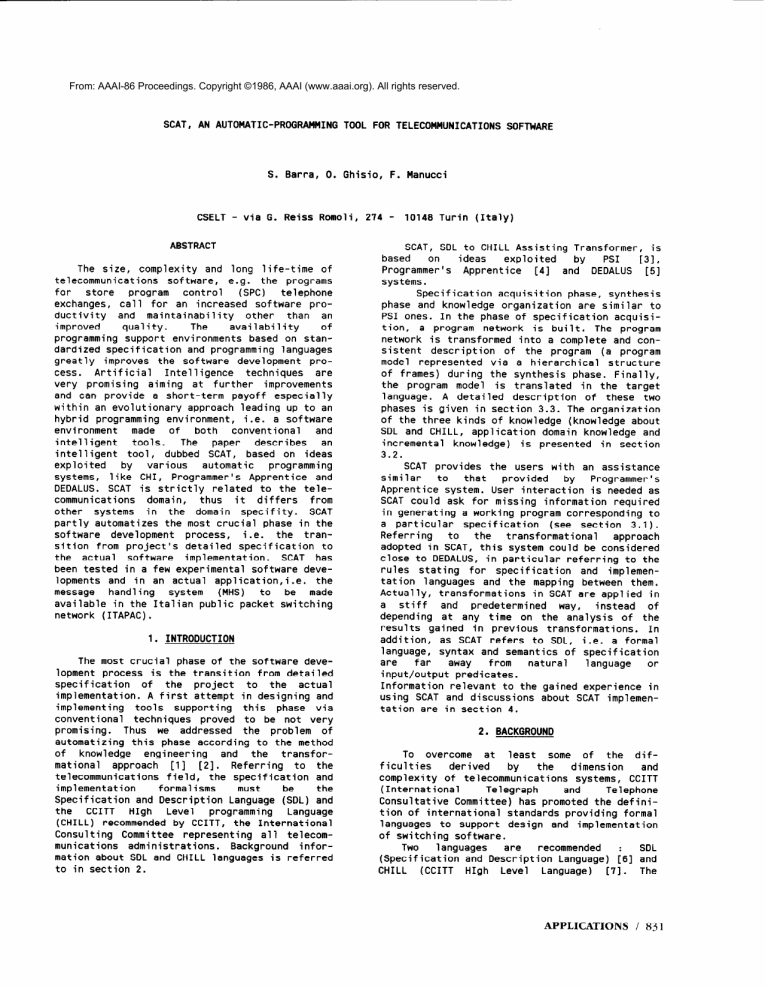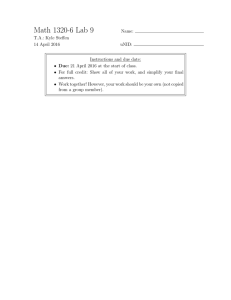
From: AAAI-86 Proceedings. Copyright ©1986, AAAI (www.aaai.org). All rights reserved.
SCAT, AN AUTOMATIC-PROGRAMMING
TOOL FOR TELECOMMUNICATIONS SOFTWARE
S.
CSELT - via
Barra,
G. Reiss
0.
Romoli,
ABSTRACT
complexity
and long 1 ife-time
of
The size,
telecommunications
software,
e.g.
the programs
for
program
control
(SPC)
telephone
store
exchanges,
call
for
an increased
software
prothan
an
ductivi ty
and
maintainability
other
qua1 ity.
The
availability
of
improved
programming
support
environments
based on standardized
specification
and programming
languages
greatly
improves
the software
development
process.
Artificial
Intelligence
techniques
are
very
promising
aiming
at
further
improvements
and can provide
a short-term
payoff
especially
within
an evolutionary
approach
leading
up to an
hybrid
programming
environment,
i.e.
a software
and
made
of
both
conventional
environment
describes
an
tools.
The
intelligent
paper
intelligent
tool,
dubbed SCAT, based on ideas
exploited
by
various
automatic
programming
systems,
like
CHI,
Programmer’s
Apprentice
and
DEDALUS. SCAT is strictly
related
to the telecommunications
domain,
thus
it
differs
from
other
systems
in
the
domain
specifity.
SCAT
partly
automatizes
the most crucial
phase in the
the
transoftware
development
process,
i.e.
sition
from project’s
detailed
specification
to
SCAT has
the
actual
software
implementation.
been tested
in a few experimental
software
developments
and in an actual
application,i.e.
the
message
hand1 ing
system
(MHS)
to
be
made
available
in the Italian
public
packet
switching
network
(ITAPAC).
1.
Ghisio,
INTRODUCTION
The most crucial
phase of the software
development process
is the transition
from detailed
specification
of
to
the
actual
the
project
implementation.
A first
attempt
in designing
and
implementing
tools
supporting
this
phase
via
conventional
techniques
proved
to be not very
Thus
we addressed
the
problem
of
promising.
automatizing
this
phase according
to the method
of
knowledge
engineering
and
the
transformational
approach
[1]
[2].
Referring
to
the
telecommunications
field,
the specification
and
implementation
formalisms
must
be
the
Specification
and Description
Language (SDL) and
Language
the
CCITT
High
Leve 1
programming
(CHILL)
recommended by CCITT,
the International
Consulting
Committee
representing
all
telecomBackground
informunications
administrations.
mation about SDL and CHILL languages
is referred
to in section
2.
274
F.
Manucci
-
10148
Turin
(Italy)
SCAT, SOL to CHILL Assisting
Transformer,
is
based
on
ideas
exploited
by
PSI
131 I
Programmer’s
Apprentice
[4]
and
DEDALUS [5]
systems.
Specification
acquisition
phase,
synthesis
phase and knowledge
organization
are similar
to
PSI ones. In the phase of specification
acquisition,
a program
network
is built.
The program
network
is transformed
into
a complete
and consistent
description
of the program
(a program
model represented
via
a hierarchical
structure
of frames)
during
the synthesis
phase.
Finally,
the program
model
is translated
in the target
1anguage.
A detailed
description
of these
two
phases is given
in section
3.3.
The organization
of the three
kinds of knowledge
(knowledge
about
SDL and CHILL,
application
domain knowledge
and
incremental
knowledge)
is presented
in section
3.2.
SCAT provides
the users
with
an assistance
similar
to
that
provided
by
Programmer’s
Apprentice
system.
User interaction
is needed as
SCAT could
ask for missing
information
required
in generating
a working
program corresponding
to
a particular
specification
(see
section
3.1).
Referring
to
the
transformational
approach
adopted
in SCAT, this
system could be considered
close
to DEDALUS, in particular
referring
to the
rules
stating
for
specification
and implementation
languages
and the mapping between
them.
Actually,
transformations
in SCAT are applied
in
stiff
a
and
predetermined
way,
instead
of
depending
at any time
on the analysis
of the
results
gained
in previous
transformations.
In
addition,
as SCAT refers
to SDL, i.e.
a formal
syntax
and semantics
of specification
1anguage,
are
far
away
from
natural
1anguage
or
input/output
predicates.
Information
relevant
to the gained experience
in
using SCAT and discussions
about SCAT implementation
are in section
4.
2.
BACKGROUND
To overcome
at
least
some of
the
difficulties
derived
by
the
dimension
and
complexity
of telecommunications
systems,
CCITT
(International
Telegraph
and
Telephone
Consultative
Committee)
has promoted the definition of international
standards
providing
formal
languages
to support
design
and implementation
of switching
software.
Two
1anguages
are
recommended
(Specification
and Description
Language)
;8] f:i
CHILL
(CCITT
High
Level
Language)
[7].
The
APPLICATIONS
/ 831
former
is usable
by both Administrations
to protelecomvide
functional
specifications
of
munications
systems
and Manufacturers,
to produce
descriptions,
i.e.
standard
documentation
(Fig.1).
The latter
is a high
level
programming
language,
fulfilling
typical
requirements
of the
specific
telecommunication
area.
SDL and CHILL languages
are rigourous
means
for specification
and implementation
activities.
However,
problems
still
remain
in the transition
from specification
to
implementation,
owing
on
one
hand
to
the
different
nature
of
the
two
languages,
on the
other
hand
to
the
specific
usage of SDL and CHILL.
The
formality
degree
required
at
SDL and
CHILL
levels
is
different,
that
is
the
first
allows
a certain
degree
of
informality
in the
specification,
while
the
second
must obey
the
strongest
formalization
rules.
SDL and CHILL definitions
have been carried
that
even
if
out
by their
own CCITT
groups,
emphasizing
compatibility
between
the languages,
designed
them under
different
points
of view.
provide
a
mean
of
SDL
is
expected
to
specifying/describing
the
behavior
of
telecommunications
systems :
for
this
reason
people
involved
in SDL definition
focused
on description
problems
specific
to the telecommunications
field.
Conversely
CHILL
is
a general
purpose
programming
language.
Thus,
CHILL provides
synlevel
high
tactic
constructs
typical
of
a
while
most
of
them
are
programming
language,
missing
in SDL grammar.
some concepts
are synAs a matter
of fact,
tactically
similar
but
semantically
different,
while
others
have
the
same semantics
but
are
syntactically
referred
to
in a different
way.
Then problems
arise
in modeling
SDL semantics
by
CHILL.
The best
way of matching
the
two languages
semantics
cannot
be immediately
identified:
a
match
can be per
formed
using
a set
of CHILL
constructs
to
reproduce
a particular
SDL concept.
On the
basis
of
the
problems
previously
outlined,
an intelligent
tool
has been developed
at
CSELT,
in
order
to
support
and
partially
automate
some phases of software
development
and
maintenance
(Fig.2)
[a].
3.
THE SCAT SYSTEM
___._~
CHILL Assisting
Transformer)
SCAT (SDL
to
is
an
intelligent
tool
providing
an assisted
transformation
in the production
of a complete
CHILL program
corresponding
to an SDL specification.
This allows
to bridge
the gap between
specification
and implementation
levels
due to the different
informality
degree
of
the
former
with
rigourous
formalism
of
the
respect
to
the
latter.
an SDL specification
SCAT takes
as
input
(see
top of Fig.3)
in a textual
form,
produced
by a set of tools
relevant
to the specification
(graphical
editor,
graphical-textual
translator,
the
output
and
produces
as
syntax
analyzer)
corresponding
CHILL code (see bottom of Fig.
3).
acquired
and analyzed
by
The specification
is
the specification
analyzer,
then
the specification
solver
performs
the
synthesis
activity,
cooperating
with
the
user’s
assistant
and consulting
the knowledge
base.
The coder
produces
the CHILL output
that
will
be
832 / ENGINEERING
processed
programming
within
support
conventional
a
environment
[9].
CHILL
prototypical
frames,
that
is
frames
not
yet
instantiated,
and then
suitably
instantiating
their
attributes.
The incremental
knowledge
is organized
in a
set
of frames
retaining
the
information
which
appears
to be reusable
during
the transformation
of
the
same and/or
other
specifications
of a
particular
project.
Such information
is
used
in transforming
SDL
tasks
into CHILL procedures
and is made of CHILL
code pieces
and some further
information
characterizing
it,
that
is parameters
types,
procedure
attributes,
file
name containing
the procedure
code.
Figure
4 shows an example of task frame instance
for
the
SDL task
MAKE ASSDCIATIDN(A,B).
This
task could be transformed
into a CHILL procedure
named MAKE-ASSOCIATION having A and B as present
parameters.
Since
this
task has been previously
classif
ied
as “procedure
with
parameters”,
a
procedural
attachment
handling
present
parameters,
is started.
The procedure
“manage-proc-wi
th-param”
recovers
the CHILL name and the present
parameters
from
the SDL name; retrieves
the formal
parameters
of
the
procedure
from
the
incremental
frame,
corresponding
to
the
MAKE ASSOCIATION
task
(Fig.5)
if it already
exists;%signs
such types
to
the
present
parameters,
suitably
instantiating
a declarative
frame.
Figure
5
shows
an
instance
of
incremental
knowledge task frame with some values
useful
for
the CHILL definition
of MAKE-ASSOCIATION
procedure.
This
kind
of
information
is
acquired
through
an user
interaction
phase and recorded
by the
system,
which
exploits
it
again,
when
needed (e.g.
for the present
parameters
definition of the task met).
The normative
knowledge
is made up of about
300 rules.
In
particular,
they
are
concerned
with :
- syntactic
rules
of SDL and CHILL
languages
(decoding
and coding rules);
- correspondence
rules
between the two languages
(equivalence
rules);
- the
rules
performing
slot
instantiation
and
retrieval
(property
rules);
some
consistency
- the
rules
checking
to be used in the updating
acticonstraints,
vity
(consistency
rules).
An example of SCAT rules
for the task concept
is
shown in Fig.
6.
The decoding
task
rule
(1)
expresses
that
the SDL primitive
at hand is a
task
if
this
primitive
consists
of a keyword
TASK followed
by the SDL name.
Two coding
rules
correspond
to the task
rule,
depending
on what
the
task
stands
for
(i.e.
abstraction
or informal
task
(2) or assignment
(3)
). The choice
of the suitable
coding
rule
depends
on the
evaluation
of
the
equivalence
rules
(6)
and
(7).
The
instance
and
the
retrieval
in the task
frame for
<SDL-NAME> and
<CHILL-NAME>
respectively
is performed
by the
property
rules
activation
(4) and (5).
3.3
Transformational
Process
In the
transformational
process
(Fig.
7),
SCAT
gradually
acquires
the
specification,
through
the
application
of
the
SDL
rules,
building
at
the
same time
the
program
model
(specification
analyzer),
suitably
instantiating
its
slots
with
those
values
at
the
moment
available
in the specification;
then,
linking
it
to
its
parent
frame.
Looking
at
those
empty
slots
in the program model,
intended
for storing
CHILL information,
SCAT becomes aware of what it
needs to issue the CHILL code. Then, it fills
up
such
slots
consulting
the
model
itself,
the
incremental
knowledge
and, when needed,
the user
(complete
mode 1
builder,
user
interface).
Finally,
it generates
the CHILL code through
the
mode 1 scanning
and
the
application
of
the
programming
rules
(coder).
As far
as the
updating
activity
is concerned,
SCAT allows
the
user
to substitute
a
chunk of a previously
acquired
specification
or
to insert
further
pieces
in it.
A submodel for
the
SOL piece
to be added or substituted
is
created
and fulf i 1 led
by the
same components
acting
in the transformation
process.
The submodel is then inserted
at the right
place
in the
starting
model ; at
the same time,
checks
are
made throughout
the whole model to identify
and
solve the possible
inconsistencies
caused by the
updating
(model modifier).
The code generation
is finally
performed
in a completely
transparent
way with respect
to the carried
out changes.
4.
EXPERIENCE OF USE AND IMPLEMENTATION
A few experimental
applications
of SCAT has
been carried
out
and the system
is presently
used in an actual
application
development
[lo].
A communication
protocol
[ll]
fully
specified
in
SDL is automatically
implemented
in CHILL using
SCAT system.
The detailed
specification
of a communication
protocol
is not an easy task:
its implementation
based on this
specification
is even more complicate,
requiring
a good knowledge
of the problem
itself.
Usually
the
implementation
of
a communication
protocol
consists
of a considerable
amount of code,
therefore
it represents
a good
test
for an automatic
translator.
This experience
made explicit
that
software
productivity
can be increased
by a factor
from 5
to 10.
SCAT system
has been developed
in PROLOG
1anguage,
in particular
in CProlog
(1.2
and 1.5
versions)
and
in Quintus
(1.2 version),
running
on VAX-11
machines
(UNIX
and VMS operating
systems)
and SUN workstations.
Some differences
of behavior,
depending
on the
PROLOG versions
and the computer
used,
have to
be
pointed
out.
Primary
requirement
to
translate
an
average-high
SDL specification
(about 500 SDL lines)
in the corresponding
CHILL
implementation
is to change the memory dimension
of CProlog.
In particular
CProlog stacks
have to
be arranged
in order
to avoid
an abort
of the
transformation
process.
The transformation
of
the
same specification
in VAX/VI%
environment
and in VAX/UNIX
environment’s
using
CProlog
1.5
APPLICATIONS
! 833
produces
two different
behaviors.
stack
dimensions
have
to
be
following
manner:
- global
stack
- local
stack
- heap stack
- trial
stack
:
:
:
:
In the
fixed
VAX/VMS
in
the
4100K
4800K
500K
150K
In the VAX/UNIX
the transformer
cannot
be run
because the greatest
dimension
of a UNIX task is
4Mb, as also occurs on Sun workstation.
CPU time required
by
The
the transformation
of the above mentioned
specification
is about
30.54
sec.
and the generated
program
is about
2,000
CHILL lines
long.
5.
CONCLUSIONS
SCAT system is based on some ideas exploited
by various
automatic
programming
systems:
PSI’s
synthesis
phase and knowledge
organization,
the
provided
by Programmer’s
assistance
approach
approach
transformational
Apprentice,
the
adopted in DEDALUS.
Actually,
SCAT does not provide
new general
it rather
shows how some ideas
applicable
ideas;
from automatic
programming
field
can be instantelecommunications
specific
tiated
in
the
domain.
Such a domain
is one of the largest
software
application
thus
it
justifies
huge
areas,
efforts
in attempting
to increase
software
prothan
to
ductivi ty
and
maintainability
other
improve its quality.
Significant
payoffs
have been achieved
in
SCAT
exploiting
AI
development
techniques
according
to evolutionary
approach which aims at
hybrid
software
environments.
First
of all,
AI techniques
allow
to improve the
cooperative
assistance
to the user and to efficiently
organize
the knowledge
required
in the
transformation
task.
Moreover,
the joint
use of frames and rules
has
allowed
to quickly
write
a first
SCAT prototype,
afterwards
tailored
to the particular
application
in a tuning
activity.
The use of Prolog
language
has outlined
its
suitability
to
evaluate
a
represent
and
knowledge
organized
in a production
rules
form;
furthermore,
it made it possible
to realize
in a
short
time
a first
prototype
of
the
system;
finally,
it assures
an easy SCAT adaptability
to
others
programming
and specification
languages.
cheaper
and more reliable
SCAT makes easier,
and
maintenance,
taking
software
development
care
of burdensome
and error-prone
tasks,
as
consistency
and match between specification
and
to
the
user
the
and
leaving
implementation,
the
most crucial
decision
responsibility
for
making.
Report
SIAN-CS-84-1008,
Kestrel
Institute
1983
D. Barstow
“The refinement
paraE. Kant,
[31
digm : the interaction
of coding and efficiency
knowledge
in program synthesis”
IEEE
Transaction
of
Software
Engineering
Vol.
SE-7 n.5 1981
C.Rich
“Inspection
methods in Programming”
[41
- Technical
Report
AI-TR-604-M.I.T.
A.I.
Labs 1981
“Synthesis
: dreams
[51 Z. Manna, R. Waldinger
-> programs”
IEEE Transaction
on Software
Engineering
Vol.
SE-5 n.4 1979
2.104
Recommendation
2.100
['31 CCITT
“Functional
Specification
and Description
Assembly
8th.
Plenary
Language
(SDL ) ”
Malaga-Torremolinos
1984
“CCITT
High
CCITT
Recommendation
2.200
[71
Plenary
Leve 1
(CHILL)”
8th.
Language
Assembly Malaga-Torremolinos
1984
[al Barra S., Ghisio O., Modesti M. “The use of
the
transforartificial
intell
igence
in
mation
from SDL to CHILL” II SDL users and
implementors
forum Helsinki
1985
“Towards
a Software
P.
et
al.
191 Bagnoli
Engineering
environment
for
telecommunication
systems
based
on CCITT
stanSwitching
dards”
XI
International
Symposium -Florence
1984
[lOI Barra S., Ghisio O., Modesti M. “Experience
and problems
of applications
of automatic
translation
from
SDL specifications
into
CHILL
implementations”
6th.
International
Conference
on
Software
Engineering
for
Sys terns
Telecommunication
Switching
Eindhoven
1986
x.411
“Message
Recommendation
1111 CCITT
8th.
Plenary
Assembly
Transfer
Layer”
Malaga-Torremolinos
1984
REFERENCES
[l]
[21
E. Lerner
“Automatic
Programming”
Computers
Software
II IEEE 1982
“Self-Described
Programming
J. Phillips
Environments-An
application
of a Theory of
Design
to
Programming
Systems”
Technical
834 / ENGINEERING
Fig.
1 - An example of SDL specification
graphical
form
in
PROCEDURAL
MAKE-ASSOCIATION
SDL NAME
I
ATTACHMENT
VALUE
SLOT
(A. 01
IMPLEMENTED
CHILL
I
I
I
COMMENT
LABEL
Lp’oc
MANAGE-PROC-WITH
chlil-name
PARAM
param-types-recover,ng
present.par-slots
Fig.
2 - The SCAT window
environment
4 - A frame
Fig.
(present
lnSfa”tlatlO”
example
NAME
present.parl
TYPEl.
types),
of
types)
program
model
PA
MAKE-ASSOC
FORMAL-PAR
ATION
l
TYDEZ
PROCEDUPE
KIND
RECURSIVE
NO
I
pr0c:
-
par,
(present-par.
VALUE
SLOT
I
(chd-name.
recovering (chfll-name);
ASSIGN-TO-PRESEtiT-PARAM
task-‘rame-recovering
assign-types
(formal-par.
(name.
name):
present-par),
(present-par.
formal-par);
end.
Fig.
(1)
TASK
(2)
<call-action>
( <present-par>
[
(3)
cSDL_name>
*comment>
<assign-act
[
<comment>
(4)
<SDL-name>
(5)
<CHILL-name>
(6)
<task>
[
<comment>
(,
CALL <CHILL-name>
<present-par>
j*
-->
]
]
;
-->
Fig.
5 - An example
of
incremental
know1 edge
<task>
)
;
ion>
I
3 - The SCAT system
-->
<CHILL-name>
;
-->
fill-slot(SDL-NAME)
-->
get-slot(CHILL-NAME)
PROGRAM MOOEL
-->
if
(7)
<task>
-->
if
Fig.
<call-action>
tSDL_name>
is
“abstraction”
is
“assignment”
CODING
PHI5E
I
I
I
CODER
<assign-action>
*SDL-name>
6 -
Example
of
rules
Fig.
7 - The transformational
process
APPLICATIONS
/ 835





